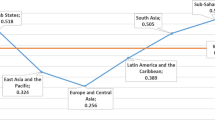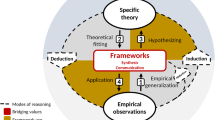Abstract
The integration of nanotechnology’s ‘social and ethical issues’ (SEI) at the research and development stage is one of the defining features of nanotechnology governance in the United States. Mandated by law, integration extends the field of nanotechnology to include a role for the “social”, the “public” and the social sciences and humanities in research and development (R&D) practices and agendas. Drawing from interviews with scientists, engineers and policymakers who took part in an oral history of the “Future of Nanotechnology” symposium at the Cornell NanoScale Facility, this article examines how nanotechnology’s ‘social and ethical issues’ are brought to life by these practitioners. From our analysis, three modes of enactment emerge: enacting SEI as obligations and problems-to-be-solved, enacting SEI by ‘not doing it’ in the laboratory, and enacting SEI as part of scientific practice. Together they paint a complex picture where SEI are variously defined, made visible or invisible, included and excluded, with participants showing their skill at both boundary-work (Gieryn Am Sociol Rev 48:781–795, 1983, 1999) and at integration. We conclude by reflecting on what this may mean for the design and implementation of SEI integration policies, suggesting that we need to transform SEI from obligations into ‘matters of care’ (Puig de la Bellacasa Soc Stud Sci 41(1):85–106, 2011) that tend to existing relationalities between science and society and implicate practitioners themselves.
Similar content being viewed by others
Notes
This participant is not identified here due to an expressed wish to remain anonymous.
We use the masculine here to reflect the predominance of males in our study and science at large.
The second level involved citing previous research in publications, and the third involved an ambiguous ‘wear[ing] your hat as a citizen of this world’… and ‘satisfy[ing] your moral side by just doing the best to promote technology you think is best,’ which again relate to enactments of SEI as personal choices.
References
Anderson B (2007) Hope for nanotechnology: anticipatory knowledge and the governance of affect. Area 39(2):156–165
Anonymous (2004, October 21) Going public. Nature 431(7011):883
Barad K (1998) Getting real: technoscientific practices and the materialization of reality. Differ J Fem Cult 10(2):87–107
Barben D, Fisher E, Selin C, Guston D (2008) Anticipatory governance of nanotechnology: Foresight, engagement, and integration. In: Hackett EJ, Amsterdamska O, Lynch M, Wajcman J (eds) The handbook of science and technology studies. MIT Press, Cambridge, pp 979–1000
Besley JC, Kramer VL, Priest SH (2008) Expert opinion on nanotechnology: risks, benefits, and regulation. J Nanoparticle Res 10:549–558
Calvert J, Martin P (2009) The role of social scientists in synthetic biology. Science & society series on convergence research. EMBO Rep 10(13)):201–204
Doubleday R, Viseu A (2009) Questioning interdisciplinarity: What roles for laboratory based social science? In: Kjolberg K, Wickson F (eds) Nano meets macro: Social perspectives on nano sciences and technologies. Pan Stanford Publishing, New Jersey, pp 51–75
Felt U, Wynne B (2007) Taking European knowledge seriously. Report of the expert group on science and governance to the science, economy and society directorate, directorate-general for research, european commission, Brussels. Retrieved June 14, 2012, from, http://ec.europa.eu/research/science-society/document_library/pdf_06/european-knowledge-society_en1.pdf
Fisher E (2005) Lessons learned from ethical, legal and social implications program (ELSI): planning societal implications research for the national nanotechnology program. Technol Soc 27:321–328
Fisher E (2007) Ethnographic invention: probing the capacity of laboratory decisions. NanoEthics 1(2):155–165
Fisher E, Mahajan R (2006) Contradictory intent? US federal legislation on integrating societal concerns into nanotechnology research and development. Sci Public Policy 33(1):5–16
Fisher E, Mahajan R, Mitcham C (2006) Midstream modulation of technology: governance from within. Bull Sci Technol Soc 26(6):485–496
Flatow I (2007, June 15) Nanotechnology. Science Friday: Making science user friendly. (New York, NY: National Public Radio.) Retrieved from, http://www.sciencefriday.com/pages/2007/Jun/hour2_061507.html
Gieryn TF (1983) Boundary-work and the demarcation of science from non-science: strains and interests in professional ideologies of scientists. Am Sociol Rev 48:781–795
Gieryn TF (1999) Cultural boundaries of science: Credibility on the line. University of Chicago Press, Chicago
Gorman ME, Groves JF, Shrager J (2004) Societal dimensions of nanotechnology as a trading zone: Results from a pilot project. In: Baird D, Nordmann A, Schummer J (eds) Discovering the nanoscale. Ios Press, Amsterdam, pp 63–73
Grunwald A (2011) Ten years of research on nanotechnology and society—outcomes and achievements. In: Zulsdorf TB, Coenen C, Ferrari A, Fiedeler U, Milburn C (eds) Quantum engagements: Social reflections of nanoscience and emergent technologies. AKA Verlag, Heidelberg, pp 41–58
Guston D (2010, May) Societal dimensions research in the National Nanotechnology Initiative. CSPO Report #10-02. (Arizona State University: Consortium for Science, Policy & Outcomes). Retrieved November 17, 2010, from http://www.cspo.org/library/title/?action=getfile&file=291§ion=lib
Haraway D (1988) Situated knowledges: the science question in feminism and the privilege of partial perspective. Fem Stud 14(3):575–599
Haraway D (1991) Simians, cyborgs and women: The reinvention of nature. Routledge, New York
Irwin A (2006) The politics of talk: coming to terms with the ‘new’ scientific governance. Soc Stud Sci 36(2):299–320
Irwin A, Wynne B (eds) (1996) Misunderstanding science? The public reconstruction of science and technology. Cambridge University Press, Cambridge, UK
Jasanoff S (ed) (2004) States of knowledge: The co-production of science and social order. Routledge, London
Jasanoff S (2011) Constitutional moments in governing science and technology. Sci Eng Ethics 17(4):620–638
Karinen R, Guston D (2010) Toward anticipatory governance: The experience with nanotechnology. In: Kaiser M, Kurath M, Maasen S, Rehmann-Sutter C (eds) Governing future technologies: Nanotechnology and the rise of an assessment regime. Springer, Dordrecht, pp 217–232
Kavli Institute (2007, June 13) Journalist’s workshop in nanotechnology. Kavli Institute at Cornell for Nanoscience, available: http://www.research.cornell.edu/KIC/events/Journalists2007/index.html
Kearnes M, Wynne B (2007) On nanotechnology and ambivalence: the politics of enthusiasm. NanoEthics 1(2):131–142
Latour B (1987) Science in action: How to follow scientists and engineers through society. Open University Press, Milton Keynes
Latour B (1988) The pasteurization of France. Harvard University Press, Cambridge
Latour B (2004) Why has critique run out of steam? From matters of fact to matters of concern. J Crit Inq 30(2):225–248
Lindee S (1994) The ELSI hypothesis. Isis 85(2):293–296
Macnaghten P, Kearnes M, Wynne B (2005) Nanotechnology, governance, and public deliberation: what role for the social sciences? Sci Commun 27(2):268–291
Markussen T (2006) Moving worlds: the performativity of affective engagement. Fem Theory 7(3):291–308
McCain L (2002) Informing technology policy decisions: the US Human Genome Project’s ethical, legal, and social implications programs as a critical case. Technol Soc 24:111–132
McCarthy E, Kelty C (2010) Responsibility and nanotechnology. Soc Stud Sci 40(3):405–432
McGinn R (2008) Ethics and nanotechnology: views of nanotechnology researchers. NanoEthics 2:101–131
McGregor J, Wetmore JM (2009) Researching and teaching the ethics and social implications of emerging technologies in the laboratory. NanoEthics 3:17–30
Meslin EM, Thomson EJ, Boyer JT (1997) Bioethics inside the beltway: the ethical, legal, and social implications research program at the National Human Genome Research Institute. Kennedy Inst Ethics J 7(3):291–298
Mody CCM (2008) The larger world of nano. Phys Today 61:38–44
Nanoscale Science, Engineering, and Technology (NSET) Subcommittee of the National Science and Technology Council (2005, March) The national nanotechnology initiative: Research and development leading to a revolution in technology and industry. Supplement to the President’s FY 2006 Budget. Retrieved June 18, 2008 from http://www.nano.gov/NNI_06Budget.pdf
Nanoscale Science, Engineering, and Technology (NSET) Subcommittee of the National Science and Technology Council (2011, February) National nanotechnology initiative strategic plan 2011. Retrieved June 18, 2012 from http://www.nano.gov/nnistrategicplan211.pdf
Nanoscale Science, Engineering and Technology (NSET) Subcommittee of the National Science and Technology Council, (2000, July) National nanotechnology initiative: The initiative and its implementation plan. Retrieved June 14, 2007 from http://www.nsf.gov/crssprgm/nano/reports/nni2.pdf
Patra D (2011) Responsible development of nanoscience and nanotechnology: contextualizing socio-technical integration into the nanofabrication laboratories in the USA. NanoEthics 5(2):143–157
President’s Council of Advisors on Science and Technology (PCAST) (2008, April) The national nanotechnology initiative: Second assessment and recommendations of the national nanotechnology advisory panel. Retrieved June 14, 2007 from http://www.nano.gov/PCAST_NNAP_NNI_Assessment_2008.pdf
U.S. Public Law 108–153 (2003) 21st century nanotechnology research and development act. 108th Congress. Retrieved June 12, 2008 from http://frwebgate.access.gpo.gov/cgi-bin/getdoc.cgi?dbname=108_cong_public_laws&docid=f:publ153.108.pdf
Puig de la Bellacasa M (2011) Matters of care in technoscience: assembling neglected things. Soc Stud Sci 41(1):85–106
Rip A (2002) Co-evolution of science, technology and society. Expert review for the Bundesministerium Bildung and Forschung’s Förderinitiative ‘Politik, Wissenschaft und Gesellschaft’ (Science Policy Studies), managed by the Berlin-Brandenburgische Akademie der Wissenschaften. (Enschede, the Netherlands: University of Twente)
Rip A (2006) A co-evolutionary approach to reflexive governance—and its ironies. In: Voss JP, Bauknecht D, Kemp R (eds) Reflexive governance for sustainable development. Edward Elgar, Cheltenham, pp 82–100
Rip A (2009) Futures of ELSA. Science & society series on convergence research. EMBO Rep 10(7):666–670
Roberts L (1993) Whither the ELSI program? Hastings Cent Rep 23(6):5
Roco M, Bainbridge WS (eds) (2001) Societal implications of nanoscience and nanotechnology: NSET workshop report. National Science Foundation, Arlington
Sandler R, Kay WD (2006) The GMO-nanotech (Dis)analogy? Bull Sci Technol Soc 26(1):57–62
Scheufele DA, Corley EA, Dunwood S, Shih T-J, Hillback E, Guston D (2007) Scientists worry about some risks more than the public. Nat Nanotechnol 2(12):732–734
Schuurbiers D (2011) What happens in the lab does not stay in the lab: applying midstream modulation to enhance critical reflection in the laboratory. Sci Eng Ethics 17(4):769–788
Schuurbiers D, Fisher E (2009) Lab-scale intervention. Science & society series on convergence research. EMBO Rep 10(5):424–427
Snow CP (2001 [1959]) The two cultures. Cambridge University Press, London
Stegmaier P (2009) The rock ‘n’ roll of knowledge co-production. Science & society series on convergence research. EMBO Rep 10(2):114–119
Suchman L (1999) Working relations of technology production and use. In: MacKenzie D, Wajcman J (eds) The social shaping of technology, 2nd edn. Open University Press, Buckingham, pp 258–265
Van Maanen J (1988) Tales of the field: On writing ethnography. The University of Chicago Press, Chicago and London
Van Oudheusden M (2011) Questioning ‘participation’: a critical appraisal of its conceptualization in a Flemish participatory technology assessment. Sci Eng Ethics 17(4):673–690
Webster A (2007) Crossing boundaries: social science in the policy room. Sci Technol Hum Values 32(4):458–479
Wolfe A (2000) Federal policy making for biotechnology, executive branch, ELSI. In: Murray TH, Mehlman MJ (eds) Encyclopedia of ethical, legal and policy issues in biotechnology, Vol. 1. Wiley, New York, pp 234–240
Wolfe A (2001) Essay review: ELSI’s revenge. J Hist Biol 34:183–193
Wynne B (1995) Public understanding of science. In: Jasanoff S, Markle GE, Petersen JC, Pinch T (eds) Handbook of science and technology studies. SAGE Publication, Thousand Oaks, pp 361–391
Wynne B (2001) Misunderstood misunderstanding: social identities and public uptake of science. Public Underst Sci 1(3):281–304
Wynne B (2007) Dazzled by the mirage of influence? STS-SSK in multivalent registers of relevance. Sci Technol Hum Values 32(4):491–503
Acknowledgments
We would like to thank participants in this study for sharing with us their time and expertise. We would also like to acknowledge support from the National Nanotechnology Infrastructure Network, where the first author worked from 2004 to 2007, under grant no. ECS-0335765 from the National Science Foundation. Finally, a warm thank you for the invaluable feedback provided by Prof. Michael Schillmeier and his students.
Author information
Authors and Affiliations
Corresponding author
Rights and permissions
About this article
Cite this article
Viseu, A., Maguire, H. Integrating and Enacting ‘Social and Ethical Issues’ in Nanotechnology Practices. Nanoethics 6, 195–209 (2012). https://doi.org/10.1007/s11569-012-0162-2
Received:
Accepted:
Published:
Issue Date:
DOI: https://doi.org/10.1007/s11569-012-0162-2




